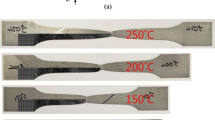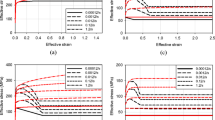Abstract
The crystallographic textures of metal sheet induced by the rolling process cause its anisotropic fracture behavior via plasticity anisotropy. This research aimed to characterize the anisotropic fracture behavior of magnesium alloy AZ31B sheet during the conventional tension-dominated forming conditions. Four specimens with different shapes were designed to cover diverse stress states, and were respectively tension-tested to fracture along the rolling direction (RD), diagonal direction (DD), and transverse direction (TD) of rolled sheet. Almost all specimens failed in the shear fracture mode with slight necking localization. The distinct differences among load response, strain distribution as well fracture strain for three directions revealed the severe anisotropic fracture characteristic. To characterize the fracture anisotropy, the isotropic modified Mohr–Coulomb (MMC) fracture criterion was revised into an anisotropic one by considering the effect of loading direction. The updated unified fracture model together with the Yld2000-3d anisotropic yield function had better performances in describing load responses of tension tests for scaled modified compact-tension (SMCT) specimens under three loading directions, especially blindly predicting their crack locations. Three SMCT specimens all failed due to the tension-dominated stress state with the stress triaxiality higher than 1/3. As a comparison, the isotropic MMC model separately calibrated by tests along the RD, DD, and TD can only predict the fracture behavior of SMCT specimen in the corresponding loading direction, but it failed to judge the fracture features of other two directions.

















Similar content being viewed by others
References
Li Y, Luo M, Gerlach J, Wierzbicki T. Prediction of shear-induced fracture in sheet metal forming. J Mater Process Technol. 2010;210:1858–69. https://doi.org/10.1016/j.jmatprotec.2010.06.021.
Park N, Huh H, Yoon JW. Anisotropic fracture forming limit diagram considering non-directionality of the equi-biaxial fracture strain. Int J Solids Struct. 2018;151:181–94. https://doi.org/10.1016/j.ijsolstr.2018.01.009.
Charoensuk K, Panich S, Uthaisangsuk V. Damage initiation and fracture loci for advanced high strength steel sheets taking into account anisotropic behaviour. J Mater Process Technol. 2017;248:218–35. https://doi.org/10.1016/j.jmatprotec.2017.05.035.
Gu B, He J, Li SH, Lin ZQ. Anisotropic fracture modeling of sheet metals: From in-plane to out-of-plane. Int J Solids Struct. 2020;182:112–40. https://doi.org/10.1016/j.ijsolstr.2019.08.004.
Li SH, He J, Gu B, Zeng D, Xia ZC, Zhao YX, Lin ZQ. Anisotropic fracture of advanced high strength steel sheets: experiment and theory. Int J Plast. 2018;103:95–118. https://doi.org/10.1016/j.ijplas.2018.01.003.
Habib SA, Lloyd JT, Meredith CS, Khan AS, Schoenfeld SE. Fracture of an anisotropic rare-earth-containing magnesium alloy (ZEK100) at different stress states and strain rates: Experiments and modeling. Int J Plast. 2019;122:285–318. https://doi.org/10.1016/j.ijplas.2019.07.011.
Qian LY, Fang G, Zeng P. Modeling of the ductile fracture during the sheet forming of aluminum alloy considering non-associated constitutive characteristic. Int J Mech Sci. 2017;126:55–66. https://doi.org/10.1016/j.ijmecsci.2017.03.013.
Basalt S, Panda SK. Failure strains of anisotropic thin sheet metals: experimental evaluation and theoretical prediction. Int J Mech Sci. 2019;151:356–74. https://doi.org/10.1016/j.ijmecsci.2018.10.065.
Safaei M, Zang SL, Lee MG, De Waele W. Evaluation of anisotropic constitutive models: mixed anisotropic hardening and non-associated flow rule approach. Int J Mech Sci. 2013;73:53–68. https://doi.org/10.1016/j.ijmecsci.2013.04.003.
Li H, Fu MW, Lu J, Yang H. Ductile fracture: experiments and computations. Int J Plast. 2011;27(2):147–80. https://doi.org/10.1016/j.ijplas.2010.04.001.
Malcher L, Pires FMA, de Sa JMAC. An extended GTN model for ductile fracture under high and low stress triaxiality. Int J Plast. 2014;54:193–228. https://doi.org/10.1016/j.ijplas.2013.08.015.
Wu H, Xu WC, Shan DB, Jin BC. An extended GTN model for low stress triaxiality and application in spinning forming. J Mater Process Technol. 2019;263:112–28. https://doi.org/10.1016/j.jmatprotec.2018.07.032.
Brünig M, Gerke S, Schmidt M. Damage and failure at negative stress triaxialities: experiments, modeling and numerical simulations. Int J Plast. 2018;102:70–82. https://doi.org/10.1016/j.ijplas.2017.12.003.
Bai YL, Wierzbicki T. Application of extended Mohr–Coulomb criterion to ductile fracture. Int J Fract. 2010;161(1):1–20. https://doi.org/10.1007/s10704-009-9422-8.
Lou YS, Yoon JW, Huh H. Modeling of shear ductile fracture considering a changeable cut-off value for stress triaxiality. Int J Plast. 2014;54:56–80. https://doi.org/10.1063/1.4850037.
Mu L, Zang Y, Wang Y, Li XL, Stemler PMA. Phenomenological uncoupled ductile fracture model considering different void deformation modes for sheet metal forming. Int J Mech Sci. 2018;141:408–23. https://doi.org/10.1016/j.ijmecsci.2018.04.025.
Talebi-Ghadikolaee H, Naeini HM, Mirnia MJ, Mirzai MA, Alexandrov S, Zeinali MS. Modeling of ductile damage evolution in roll forming of U-channel sections. J Mater Process Technol. 2020;283: 116690. https://doi.org/10.1016/j.jmatprotec.2020.116690.
Steglich D, Wafai H, Besson J. Interaction between anisotropic plastic deformation and damage evolution in Al 2198 sheet metal. Eng Fract Mech. 2010;77(17):3501–18. https://doi.org/10.1016/j.engfracmech.2010.08.021.
Luo M, Dunand M, Mohr D. Experiments and modeling of anisotropic aluminum extrusions under multi-axial loading—part II: ductile fracture. Int J Plast. 2012;36:34–49. https://doi.org/10.1016/j.ijplas.2012.03.003.
Gu GY, Mohr D. Anisotropic Hosford–Coulomb fracture initiation model: theory and application. Eng Fract Mech. 2015;147:480–97. https://doi.org/10.1016/j.engfracmech.2015.08.004.
Shen FH, Münstermann S, Lian JH. Investigation on the ductile fracture of high-strength pipeline steels using a partial anisotropic damage mechanics model. Eng Fract Mech. 2020;227: 106900. https://doi.org/10.1016/j.engfracmech.2020.106900.
Li ZG, Yang HF, Liu JG. Comparative study on yield behavior and non-associated yield criteria of AZ31B and ZK61 M magnesium alloys. Mater Sci Eng A. 2019;759:329–45. https://doi.org/10.1016/j.msea.2019.05.053.
Dunand M, Maertens AP, Luo M, Mohr D. Experiments and modeling of anisotropic aluminum extrusions under multi-axial loading—part I: plasticity. Int J Plast. 2012;36:34–49. https://doi.org/10.1016/j.ijplas.2012.03.003.
Qian LY, Ji WT, Sun CY, Fang G, Lian JH. Prediction of edge fracture during hole-flanging of advanced high-strength steel considering blanking pre-damage. Eng Fract Mech. 2021;248: 107721. https://doi.org/10.1016/j.engfracmech.2021.107721.
Boyce BL, Kramer SLB, Fang HE, et al. The Sandia fracture challenge: blind round robin predictions of ductile tearing. Int J Fract. 2014;186(1–2):5–68. https://doi.org/10.1007/s10704-013-9904-6.
Acknowledgements
The authors greatly acknowledge the financial support by the National Natural Science Foundation of China (No. 52275305, No.51805023), Beijing Natural Science Foundation (No. 3184056), and Fundamental Research Funds for the Central Universities (No. FRF-IDRY-20-024, No. FRF-TP-20-009A2).
Author information
Authors and Affiliations
Corresponding authors
Ethics declarations
Conflict of interest
The authors declare that they have no conflict of interest.
Ethical approval
The authors declare that the research was conducted according to the ethical standards.
Additional information
Publisher's Note
Springer Nature remains neutral with regard to jurisdictional claims in published maps and institutional affiliations.
Rights and permissions
Springer Nature or its licensor holds exclusive rights to this article under a publishing agreement with the author(s) or other rightsholder(s); author self-archiving of the accepted manuscript version of this article is solely governed by the terms of such publishing agreement and applicable law.
About this article
Cite this article
Qian, L., Xu, S., Li, H. et al. Influences of stress states and loading directions on the anisotropic fracture of magnesium alloy AZ31B sheet under tension-dominated forming conditions. Archiv.Civ.Mech.Eng 22, 213 (2022). https://doi.org/10.1007/s43452-022-00535-0
Received:
Revised:
Accepted:
Published:
DOI: https://doi.org/10.1007/s43452-022-00535-0




